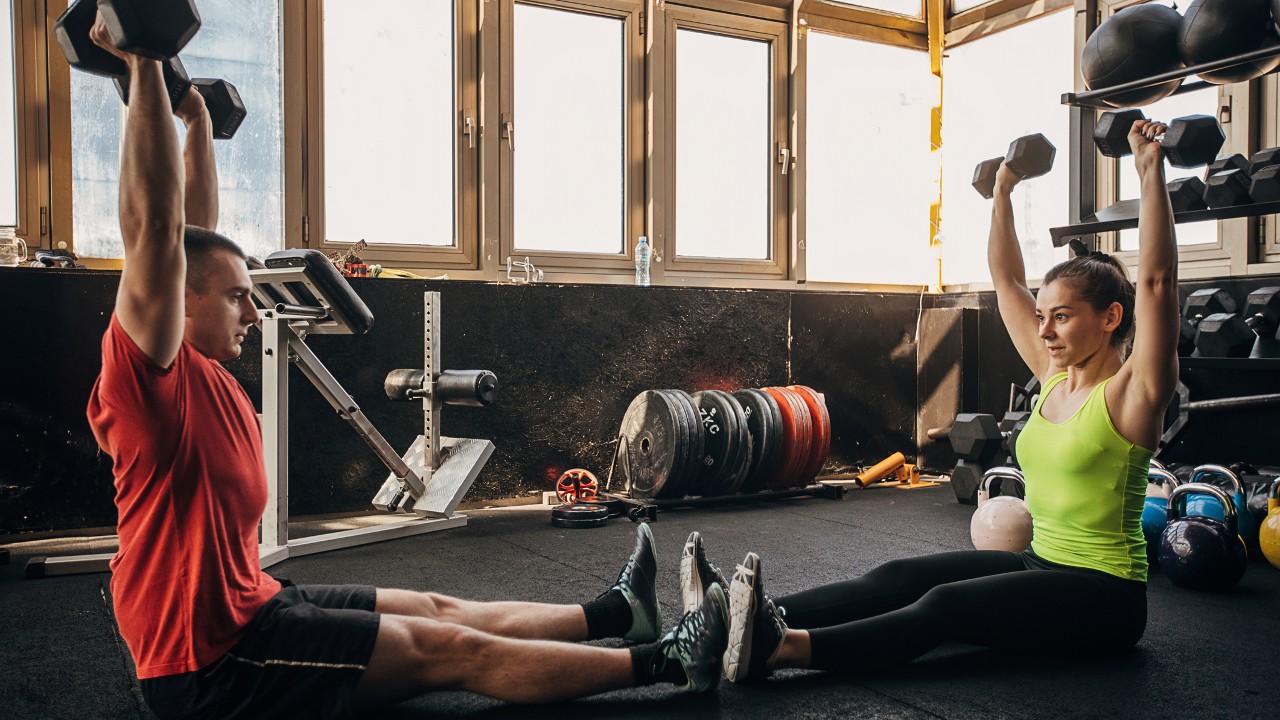
At a glance, the Z-press looks easy. Popularized by the Lithuanian strongman Žydrūnas Savickas, this exercise is basically an overhead press performed while sitting on the floor with your legs straight. But don’t let its simplicity fool you. The Z-press requires strength in your shoulders and core, plus flexibility in your hamstrings and hip flexors, and there’s no way to cheat. Without a doubt, the Z-press takes pride of place among the best shoulder exercises for developing mobility, stability and co-ordination.
However, your technique needs to be on point if you want to reap all the benefits of the Z-press. Good form is also crucial to avoid painful shoulder injuries and reduce unnecessary strain on your lower back. To help you master the Z-press, we asked strength and mobility experts to share their best training tips. Read on for top-notch advice on how to perform this challenging movement safely and effectively.
Z-Press Benefits
The Z-press is much more than a bodybuilding exercise. “The Z-press mimics the position in all sorts of push exercises. It really builds a lot of stability inside the shoulder,” says Cody Mooney, a former CrossFit Games athlete and the director of performance for the mobility and recovery app pliability. As a result, incorporating this exercise into your workout routine can help you master more complex movements, such as a handstand push-up.
The Z-press is also a useful exercise if you want to increase your mobility, especially around your thoracic spine and shoulder blades. That’s according to Mitch Raynsford, a certified strength and conditioning coach at P3RFORM, a digital fitness coaching platform. “I always advocate using strength training to improve range of motion,” he says. “If you just do mobility and flexibility exercises, you can be flexible throughout the range of motion, but you might not be strong in those ranges, top and bottom.”
Which muscles does the Z-press work?
The Z-press is a great exercise to build strength and mass in your front and middle deltoids—the muscles that sit on the top of your shoulders. And since beefed-up deltoids give the shoulder a rounded contour, the Z-press can be a great tool for creating the V-shaped physique popular with bodybuilders, too. But the benefits don’t end there. Well-developed deltoids are essential for stabilizing the shoulder joint, particularly during challenging push-pull compound movements. And just like a regular overhead press, the Z-press also engages your triceps and the upper portion of your chest muscles.
The Z-press mainly targets muscles in your arms and shoulders, but you will feel the effects of this exercise all over your upper body. That’s because being sat down challenges the body in a unique way. “It takes any kind of drive away from your legs, and really teaches you how to properly press with your upper body,” says Mooney. “Sitting down also gets you in a really good position to activate your upper back muscles.” For example, engaging your lats and rhomboids is crucial for maintaining a stable, upright posture.
The Z-press is also great for building core strength and stability. “When you perform this exercise, you really need to learn how to recruit your core muscles so you don’t lean back,” Mooney said. Your abdominals and obliques will help shield the spine and rib cage from strain.
Is the Z-press suitable for everyone?
The Z-press is a big step up from the classic standing overhead press. It requires more strength, body awareness and core control, but most importantly more mobility. If you want to reap all the benefits of the Z-press, you need to have a good range of motion in your hips and shoulders. “Otherwise, you’re risking an injury, because you’re going to be heavily compensating with different muscles,” says Mooney.
The Z-press is not suitable for everyone. If you find it particularly difficult to lower the bar, this can be a red flag. “If you’re trying to fight your elbows coming in, and it feels like you’re almost cramping, then it’s a sign you may need to work more on your mobility,” says Mooney.
Trouble getting into the position would be another sign you need to improve your mobility first. “Before you even attempt the Z-press, make sure that you have the ability to hinge. To get into this position, good hamstring mobility is essential,” says Don Saladino, a celebrity personal trainer and Lumen ambassador.
If you do not have enough core strength and mobility, performing an overhead press on a bench may be a better option. “This way you can press safely, without arching your back or straining your shoulder joint,” Saladino says. “And if you can’t press a weight overhead, choose an exercise where you press from a different angle, such as a landmine press.” Combine a seated press with back mobility exercises, such as wall angels. “These exercises will really help you get into the position and engage the right muscles before you bring in the explosive Olympic lifts,” says Raynsford.
Lastly, avoid the Z-press altogether if you have pre-existing injuries. “If you have any sort of shoulder impingement or strain, you wouldn’t want to go through any explosive movements through the joint,” says Raynsford. “Work with your physiotherapist to understand what prehab and rehab exercises you need to do. Only attempt the Z-press once it’s signed off as safe for you to perform.”
How To Do The Z-Press
Sit upright, gripping the bar with hands just wider than shoulder-width apart. Aim to keep your hamstrings flat on the floor so your lower back remains tight. Press the bar overhead and push your head through the window created by your arms at the top of each rep—this’ll keep your shoulders healthy.
“Same as with the push-up, go for a 45° angle with the elbows. Pressing slightly in front of you is going to allow you to work more towards front delts rather than getting pinched through the shoulders. Make sure to keep your shoulder blades retracted and depressed,” says Raynsford. And absolutely do not lean back during tough reps or break the sitting position when you’re not lifting.
“Hyperextending can place a lot of stress on the lumbar spine. Make sure you’re able to keep that neutral spine throughout the exercise,” says Raynsford. Resist the urge to break your form by tightening up your core muscles and pressing your hips into the ground.
Get the Coach Newsletter
Sign up for workout ideas, training advice, reviews of the latest gear and more.
Z-press Form Tips
1. Switch To Dumbbells
Why “I’m a big fan of using dumbbells during the Z-press, because you can’t overcompensate on one arm,” says Mooney. “With a barbell, you sometimes start using more of your dominant arm. And because dumbbells take away some of the stability, your shoulders need to work all those little stabilizing muscles too.”
How Since the dumbbell Z-press is slightly more difficult than the barbell Z-press, make sure you go for lighter weights.
2. Slow Down On Your Way Down
Why “One of the best ways to increase intensity is to go slow on your way down. Increasing the time under tension fatigues your shoulder without the need to use a ton of weight,” says Mooney.
How “You can get creative and mix your rep scheme or the descent time—there are many different ways to build muscles without the fear of hurting yourself,” says Mooney. For example, lower your bar on a count of three.
3. Don’t Skimp On Safety Measures
Why The Z-press is a challenging movement, so make sure you have safety measures in place.
How “Keep safety bars close at hand. If you can’t rack it, then ask someone to spot you so the barbell doesn’t land on you,” Raynsford said.
Z-Press Vs Overhead Press
Both the Z-press and the overhead press involve lifting a bar above your head to build mass and strength in the shoulder muscles. However, the difference in lower-body position changes muscle engagement. “In the Z-press, there’s more focus on your thoracic mobility and a lot more stress through your shoulders and triceps than with a normal overhead press,” says Raynsford. “You’re not allowed to cheat in any way—you have to do it correctly. If you don’t, then the barbell is not going up.” As a result, the Z-press is a better choice for more advanced exercisers, but even seasoned gym-goers will need impeccable mobility to perform this exercise safely.
Another notable difference is the maximum possible load you’ll be able to press. The overhead press allows you to put more weight on the bar. That means if shoulder strength is at the top of your priority list, you may be better off ditching the Z-press in favor of the overhead press.
On the other hand, the Z-press may be a better option if you struggle to isolate your shoulders. “If you have a tendency to flex your knees or your hips during a standing overhead barbell press, a bit of the work will come from your legs. By doing the Z-press, you take out all of that legwork, and rely on your rear delts,” says Raynsford. “So there’s no way of really cheating it.”
About Our Experts

Cody Mooney is the director of performance for the mobility and recovery app pliability. Cody started doing CrossFit when he was 15, and became a coach at his local gym at 16. After deciding to pursue a career in CrossFit, he became a two-time CrossFit Games athlete in 2019, and was part of the second fittest team in the world.

Mitch Raynsford is a certified personal trainer, UKSCA-accredited S&C coach, and the lead strength and conditioning coach at digital fitness coaching platform P3RFORM. He holds a MSc degree in Sports Science and Applied Sports Physiology from the University of Brighton. Mitch has worked for Aston Villa Women football club as the lead trainer preparing players for a return to competitive matches, and also took on the role of sports scientist with the senior squad.

Don Saladino has trained celebrities including Ryan Reynolds, John Krasinski and Blake Lively, and has appeared on the cover of Muscle & Fitness magazine twice. He is NASM-certified and opened the New York City gym Drive 495 in 2005.

Anna Gora is a health writer and certified PT with more than a decade’s experience in the fitness industry. She provides online health coaching to people as part of the UK’s Healthier You: NHS Diabetes Prevention Programme and has a master’s degree in Nutrition, Physical Activity & Public Health from the University of Bristol. As well as Coach, Anna also contributes to sister site Fit&Well and science news website Live Science.









